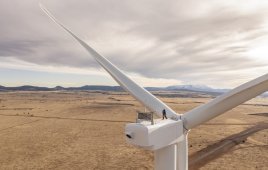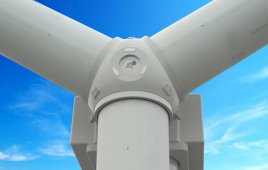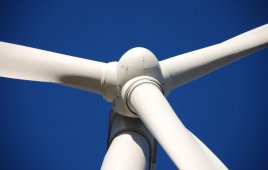Wind turbines, like helicopters, are fatigue machines—always vibrating and working to loosen their fasteners. More vibration will come as engineers develop longer blades to capture more wind energy and towers reach higher to accommodate them. These increased vibration levels will loosen some tower fasteners. To prevent this, engineers are looking for better ways to measure tension (than torque) and prevent corrosion. Finally, fastening companies are becoming more wary of costs especially as they count toward total cost of ownership (TCO).
Torque control is a risky way to achieve consistent pretension in structural bolts. As Barnaby Myhrum, application engineer at Applied Bolting Technology, explains it all comes down to the k-factor, the relationship between the torque applied to a fastener assembly and the actual tension reached in the bolt.
K-factors range from 0.10 to 0.20. “Add in the variability of torque tools and you can bet that when using torque control to generate a precise load, actual bolt tensions will vary ± 40% or more,” Myhrum explains. He says crews can find a better tension indicator in the squirter direct tension indicator—a washer that tells when a target tension had been reached in a bolt, regardless of the applied torque. When the bumps on the washer compress sufficiently, bright colored silicone squirts from cavities under the bumps. The bump compression and squirt appearance are calibrated to a required tension. GL certifies that the devices for M36, M42, and M48 bolts will reach target tension ±10%.
Other construction trends deal with ways to keep bolts tight. VP of Disc-Lock International Greg White says a locking washer can eliminate fastening failure. “The device consists of two preassembled washer-shaped pieces that have inclined cams on one side with a series of radial ridges on the other. These cam sides are placed between the nut and joint material. The cam angle is greater than the bolt-thread-pitch angle so the interlocking cams and non-slip ridges of the washer jam to prevent the nut from loosening under vibration.”
Tension-control bolts are replacing some conventional high-strength friction-grip ones, says White, because they are quick and easy to install with a lightweight electric shear wrench. “Guaranteed tension and a visual inspection eliminates the likelihood of operator error and ensures engineers that connections are tightened according to specifications,” he says. Another perk of this bolting system is that it is easily removed and reused, which saves costs. Other types of secure bolts are not easily removed and must be burned or cut off destroying the bolt and requiring purchase of a new one. White says another way to trim costs is by using an electrically powered shear wrench that’s lighter than hydraulic wrenches. It requires one worker and improves safety. “The shear wrench uses two sockets that rotate in opposite directions, allowing the nut to turn while the bolt remains stationary,” he says. “The counter-force operation transfers no torque to the operator thereby reducing fatigue that can cause carpal tunnel syndrome.”
In addition to keeping bolts tight, operators must protect them against corrosion. This will become more important as turbines head offshore. Coatings, such as Magni 501 from the Magni Group Inc. helps keep nuts, bolts, screws, and other types of hardware from corroding. The silver coat is a replacement for zinc plating and trivalent passivation, and can be applied in dip/spin or spray methods.
The industry is also growing more concerned about total cost of ownership. John Grabner, president of Cardinal Fastener & Specialty Co., says procurement managers must ask themselves several questions when submitting a quote for safety-critical fasteners. “When erecting a $3 million turbine, safety-critical fasteners amount to less than 1% of the total cost,” he explains. “More than just price must go into a procurement decision. Taking quality, delivery, and service into consideration will help lower TCO.” If a fastener doesn’t meet high quality standards, projects may incur costs related to replacing the parts or eventually repairing the turbine, he says. Choosing a domestic source also affects TCO, because OEMs can purchase products and have them delivered quickly to sites for construction and fabrications. Waiting for deliveries from overseas suppliers may result in expedited air-freight charges, lost or misplaced goods, and or liquidated damages. Hence, the shorter the supply chain, the better.
WPE
Filed Under: Components, Turbines




